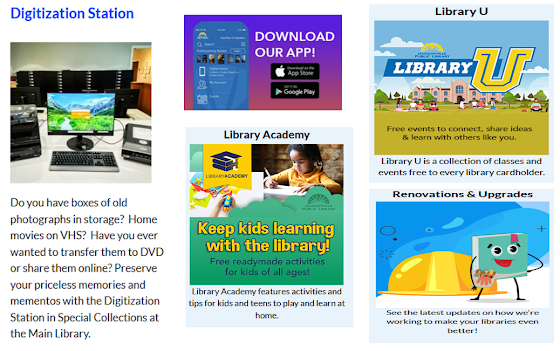 |
| ala.org |
Libraries
are so much more than “just books!” This truth is recognized in
this year’s National Library Week theme, “Connect with Your
Library.” This week, April 3 – 9, librarians all across our
country will be promoting libraries as places to get connected
through technology – providing free internet connections,
computers, maker-spaces, and digital resources.
They will also be providing opportunities for people to connect
with one another through free library programs and classes. And,
don’t worry, they will also promote connecting with ideas through
printed books.
Librarians work tirelessly to connect with their communities
through a vast array of technologies, materials, and services. Why?
 |
| usc.edu |
Perhaps the answer may be found in just 26 words written in 1931
by Dr. Shiyali Ramamrita Ranganathan (1892-1972). Dr. Ranganathan is
one of the greatest figures of librarianship. He is best known for
his considerable contributions to the theory of classification and
subject retrieval but Dr. Ranganathan studied all aspects of
librarianship.
He formulated Five Laws of Library Science based
upon his scientific training, his training as a librarian, and his
rigorous, objective analysis.
Dr. Ranganathan
wrote these words before the
internet,
before our
digital age. Rather than
rewriting the “5 Laws,” let’s examine
how they still apply today.
1. Books are for use.
The term
‘books’
should be interpreted broadly to mean
all types of library materials.
This law removes
restrictions and ensures
maximum use of library
materials. Libraries today
are no longer simply destinations which house a physical collection
of printed books. Library
materials, thanks
to technologies, are
everywhere. “Books
are for use,” means
that a library’s
collection is not shut away
from users… and this concept pertains to access
of all forms of library
materials – print,
digital - regardless
of format—within and
outside the physical library.
2. Every person
his/her book.
All
library users are entitled to the materials they need. A library
serves all
members
of the community,
no matter their age, race, or economic status. This means that
libraries
serve many different groups and
build
collections
(print,
media, digital, etc.)
to
accommodate many needs, but
they
do
not sit in judgment of library
users’ choices.
The
explosion
of digital and online sources expands
and reinforces the need for libraries
to continue
to meet the special interests of the community, and promote library
services to attract a wide range of readers.
3. Every book its reader.
“Every
book its
reader,”
can be interpreted to mean that every library
resource is useful to an individual(s),
no matter how specialized and no matter how small the audience may
be. This
law applies to all information, not just print books. Libraries
now manage extraordinarily complex collections and
services that
encompass a broad range of physical and digital resources.
4. Save the time of the reader.
“Save
the time of the reader,” dictates that all library
users
should be able to locate the material they desire easily, quickly and
efficiently. Librarians
must possess
strong reference skills for
both print and digital materials,
but also strong technical skills in cataloging, cross-referencing,
ordering, accessioning, and the circulation of all
types of library materials.
5. The library is a growing organism.
“The
library is a growing organism,” requires that a library must
continually change,
Thanks to Dr. Shiyali Ramamrita Ranganathan's 26 words - his Five Laws of Library Science - we celebrate National Library Week! National Library Week highlights
the essential role libraries,
librarians and library workers play in serving their communities.
Libraries aren’t
“just books” nor are
librarians and library workers just “collecting
a paycheck.” By following
the “Five Laws of Library Science,” libraries,
librarians and library workers ensure
you receive free access to all types of library materials and
services easily,
quickly, and efficiently.













No comments:
Post a Comment